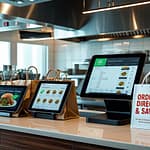Key Takeaways:
- Understand your restaurant’s cash flow to accurately predict income and expenses.
- Allocate a specific percentage of your revenue to different operational areas like food, labor, and overhead costs.
- Regularly review and adjust your budget to reflect changes in the market or your business operations.
- Incorporate a contingency fund into your budget to manage unexpected expenses or downturns.
- Use restaurant budgeting software or financial consultants to ensure accurate and efficient planning.
Introduction: Why a Realistic Restaurant Budget Matters
Creating a realistic budget is one of the most critical steps in managing and growing a successful restaurant. Yet, many owners and managers overlook its importance or underestimate the complexity involved. Without clear financial planning, restaurants can quickly find themselves in difficult cash flow situations, unable to meet obligations or invest in growth opportunities. A realistic budget provides clarity, control, and confidence—ensuring your restaurant stays profitable and sustainable over time.
In this guide, we’ll walk through practical steps to set up a budget tailored to your restaurant’s operations, explore common pitfalls to avoid, and demonstrate how proper financial planning leads to stronger cash flow management.
Understanding the Basics of Restaurant Budgeting
Before diving into specifics, it’s essential to understand what a restaurant budget entails. Simply put, a restaurant budget outlines anticipated revenues and expenses over a specific period, typically monthly or annually. This financial blueprint helps you monitor your restaurant’s financial health, identify opportunities for improvement, and plan proactively for future investments.
Why Restaurant Budgeting is Crucial
- Cash Flow Management: Proper budgeting ensures your restaurant maintains adequate cash flow to cover daily operations, payroll, inventory, and unexpected expenses.
- Decision Making: Budgets provide data-driven insights to help you make informed decisions about menu pricing, staffing levels, marketing campaigns, and equipment upgrades.
- Goal Setting and Performance Tracking: With a realistic budget, you can set achievable financial goals and regularly measure your restaurant’s performance against these benchmarks.
Step-by-Step Guide to Creating Your Restaurant Budget
Step 1: Analyze Historical Financial Data
Begin by reviewing your restaurant’s historical financial statements, ideally from the past year or two. Analyzing past sales, expenses, and profit margins helps identify trends, seasonal fluctuations, and potential areas for improvement. Consider the following:
- Monthly revenue averages and variations
- Operating costs—food costs, labor expenses, overhead expenses
- Seasonal impacts on sales and expenses
- Unexpected or irregular costs incurred previously
Step 2: Determine Your Revenue Projections
Establish realistic revenue projections based on historical performance, market conditions, and current trends. Factor in anticipated changes, such as menu adjustments, pricing strategies, or marketing initiatives. To project revenues, consider:
- Average number of covers per day or week
- Average spend per customer
- Impact of promotional events or special menus
- Seasonal or economic factors affecting customer behavior
Step 3: Categorize Your Expenses Clearly
Clearly categorize your expenses to understand precisely where your money goes. Typical restaurant expenses include:
- Food and Beverage Costs: ingredients, beverages, inventory
- Labor Costs: wages, salaries, benefits, payroll taxes
- Occupancy Expenses: rent, utilities, property taxes, insurance
- Operational Expenses: cleaning supplies, uniforms, maintenance, licenses
- Marketing Expenses: advertising, promotions, social media management
- Administrative Expenses: accounting, legal fees, office supplies, software subscriptions
Step 4: Calculate and Monitor Key Ratios
Monitoring key financial ratios helps you quickly assess your restaurant’s financial health. Critical ratios to track include:
- Food Cost Percentage: Total food costs divided by total food sales; typically 28-35%
- Labor Cost Percentage: Total labor costs divided by total sales; typically 25-35%
- Prime Cost Percentage: Combined food and labor costs divided by total sales; ideally below 60-65%
Regularly tracking these ratios helps you spot potential issues early and adjust your budget proactively.
Step 5: Set Aside Funds for Unexpected Expenses
No restaurant is immune to unexpected costs—equipment breakdowns, unexpected repairs, or sudden market price hikes. Establishing an emergency fund within your budget helps you manage unforeseen expenses without disrupting your cash flow. Aim to set aside approximately 5-10% of your monthly revenues for contingency purposes.
Common Budgeting Mistakes to Avoid
Even experienced restaurateurs can fall prey to budgeting pitfalls. Being mindful of common errors helps protect your financial stability:
- Overestimating Revenues: Be realistic, not overly optimistic, when forecasting sales. Inflating expected revenues can lead to overspending and cash flow problems.
- Ignoring Seasonal Trends: Restaurants often experience significant seasonal fluctuations. Factor these variations into your budget to avoid surprises.
- Neglecting Regular Budget Reviews: A budget is a living document. Regularly review and update your budget, adjusting projections and expenses as needed.
- Underestimating Costs: Always account for inflation, price changes, and unexpected expenses. Regularly review vendor contracts and industry reports to stay informed.
Real-World Example: Budgeting Success Story
Consider a neighborhood Italian restaurant struggling with inconsistent cash flow. By closely examining their historical financial data, the owners realized their food cost percentage exceeded industry benchmarks due to waste and inefficient inventory management. They implemented a comprehensive budgeting plan that included strict inventory controls, portion standardization, and better vendor negotiations.
Within six months, they reduced their food cost percentage from 40% to 30%, significantly improving their profitability and cash flow stability. This budgeting discipline also allowed them to reinvest surplus funds into marketing campaigns, driving additional customer traffic and further growing revenues.
Implementing Budgeting Tools and Technology
Leveraging budgeting software and restaurant-specific financial tools simplifies the budgeting process and enhances accuracy. These tools provide:
- Real-time insights into financial performance
- Automated tracking of key ratios and expenses
- Easy forecasting and scenario modeling capabilities
Popular restaurant budgeting software includes tools like QuickBooks, Restaurant365, and Toast’s POS-integrated solutions. Choose a platform that aligns with your restaurant’s size, complexity, and financial management needs.
Conclusion: Building a Budget That Supports Your Success
Setting a realistic, well-structured budget is essential for the long-term success and sustainability of your restaurant. By carefully analyzing historical data, accurately forecasting revenues and expenses, monitoring key financial ratios, and avoiding common budgeting pitfalls, you position your business for financial stability and growth.
Remember, budgeting is not a one-time task but an ongoing process requiring regular attention, review, and adjustment. When executed correctly, restaurant budgeting delivers improved cash flow management, informed decision-making, and greater confidence in your restaurant’s financial future.






Comments
Be the first to comment on this article.